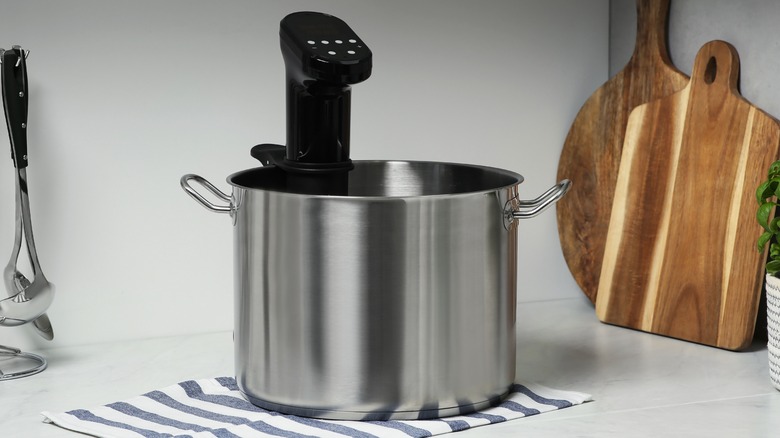Skip The Microwave When Reheating Leftovers And Sous Vide Them Instead
You know the experience: You've spent your evening making a fabulous dinner. It turns out delicious, flavorful, exactly how you want it — and even better, you made more than you need. You've got leftovers for lunch the next day. When you sit down to eat them, though, they have come out of the microwave overcooked, dry, and less tasty than the night before. It too often feels like a necessary evil of eating leftovers, that they won't be nearly as good as the original meal. It is an avoidable hazard, though, if you turn to sous vide.
Sous vide is a simple cooking method that starts with food in an airtight container (typically a vacuum-sealed bag). The container of food is submerged and cooked in water that's kept at a constant temperature and circulated by a sous vide machine. The vacuum-packed food will cook slowly and won't heat past the temperature to which you set the machine, so the sous vide method allows for more control over the cooking process, and you don't have to worry about uneven temperatures or overcooking.
This is why sous vide is particularly handy for leftovers, especially proteins like chicken, fish, and steak. Sous vide gets the food reheated to the right temperature throughout without overcooking and without sacrificing flavor — as the microwave too often does.
Invest the time to keep flavors preserved
When you reheat food in the microwave, it starts to recook and dry out. Meats especially become tough and lose all their original tenderness and flavor, while vegetables tend to get soft and soggy. All sous vide will do, though, is heat leftovers through and bring them back up to temperature. Since the sous vide method requires food to be in an airtight container so that it won't float on top of the water, the food won't get dried out by extra air, fall victim to moisture evaporation, or lose a ton of flavor — instead, it'll stay tender inside the vacuum seal.
Microwaves are a quick and easy zap of a few minutes, but sous vide will require a lot more of a time commitment. You'll have to start by vacuum sealing your food, but if you plan to sous vide, it's a good way to store leftovers in your refrigerator. Since the method heats food slowly to keep everything at a careful, consistent temperature, some foods — like a thick steak — can take as much as a couple of hours to reheat. Fish can take as little as 20-30 minutes, though, and reheating soup will probably take around 45 minutes. Although it will require more preparation and a time commitment, knowing that your food will come out as flavorful as when cooked fresh will be well worth the wait.
Get the reheating right
When reheating, the sous vide temperature should be set to around or slightly below the original cooking temperature. If you have it set higher, you'll risk overcooking the food. But you want to make sure that it's reheated to a safe temperature — which for any type of leftovers is 165 degrees Fahrenheit, according to FoodSafety.gov. If you sous vide around the original cooking temperature, the reheating time will probably be around the same or a little less than the original cooking time. The method is pretty tolerant, though, so if you leave the food in the water bath for a bit longer than intended (even an hour), you'll likely be just fine.
This also makes sous vide a great hands-on reheating method. You won't have to stand next to the microwave to stick your finger in the mashed potatoes every 45 seconds or so to check if they're warmed through, and you won't have to rush around to make sure everyone's dinner is coming out hot when the family is ready to sit down. With some planning, you can stick your leftovers in the sous vide water bath to reheat — then return to them when you're good and ready for food that's just as delicious as the first time around.


